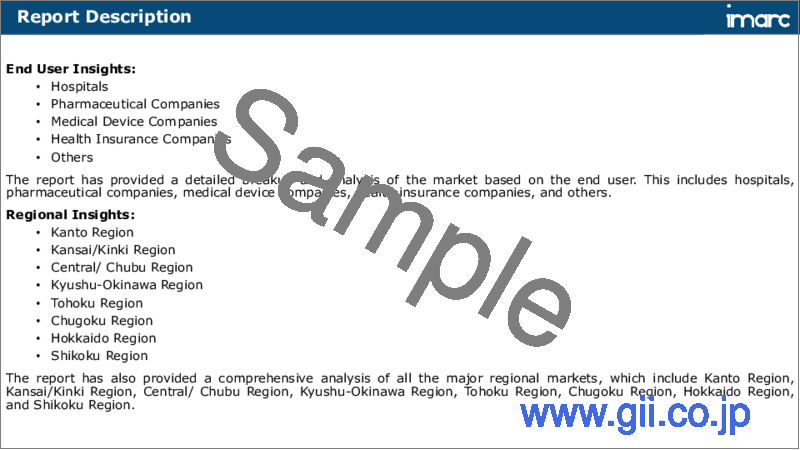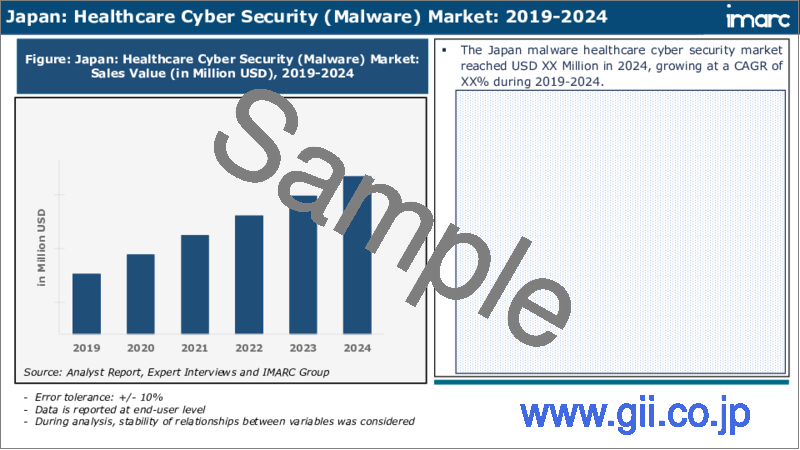|
|
市場調査レポート
商品コード
1746501
日本の医療用サイバーセキュリティ市場の分析:脅威の種類別、ソリューションの種類別、エンドユーザー別、地域別(2025~2033年)Japan Healthcare Cyber Security Market Report by Type of Threat (Malware, Distributed Denial of Service, Advanced Persistent Threats, Spyware, and Others), Type of Solution, End User, and Region 2025-2033 |
||||||
カスタマイズ可能
|
|||||||
| 日本の医療用サイバーセキュリティ市場の分析:脅威の種類別、ソリューションの種類別、エンドユーザー別、地域別(2025~2033年) |
|
出版日: 2025年06月02日
発行: IMARC
ページ情報: 英文 115 Pages
納期: 5~7営業日
|
全表示
- 概要
- 目次
日本の医療用サイバーセキュリティの市場規模は2024年に13億米ドルに達しました。今後、IMARC Groupは、同市場が2033年までに53億米ドルに達し、2025年から2033年にかけて15.7%の成長率(CAGR)を示すと予測しています。同市場は、電子カルテ(EHR)や遠隔医療サービスの利用の増加、データ漏洩やサイバー攻撃による被害に対する認識の高まりなど、いくつかの重要な要因によって推進されています。
当レポートで扱う主な質問
- 日本の医療用サイバーセキュリティ市場はこれまでどのように推移し、今後どのように推移するのか?
- COVID-19が日本の医療用サイバーセキュリティ市場に与えた影響は?
- 日本の医療用サイバーセキュリティ市場の脅威の種類別の内訳は?
- 日本の医療用サイバーセキュリティ市場のソリューションの種類別の内訳は?
- 日本の医療用サイバーセキュリティ市場のエンドユーザー別の内訳は?
- 日本の医療用サイバーセキュリティ市場のバリューチェーンにおける各ステージとは?
- 日本の医療用サイバーセキュリティ市場の主要な促進要因と課題は何か?
- 日本の医療用サイバーセキュリティ市場の構造と主要プレーヤーは?
- 日本の医療用サイバーセキュリティ市場における競合の程度は?
目次
第1章 序文
第2章 分析範囲・手法
- 分析目的
- ステークホルダー
- データソース
- 市場推定
- 分析手法
第3章 エグゼクティブサマリー
第4章 日本の医療用サイバーセキュリティ市場:概要
- 概要
- 市場力学
- 業界動向
- 競合情報
第5章 日本の医療用サイバーセキュリティ市場の情勢
- 過去・現在の市場動向(2019~2024年)
- 市場予測(2025~2033年)
第6章 日本の医療用サイバーセキュリティ市場:脅威の種類別の内訳
- マルウェア
- DDoS(分散型サービス拒否)
- APT(高度な持続的脅威)
- スパイウェア
- その他
第7章 日本の医療用サイバーセキュリティ市場:ソリューションの種類別の内訳
- ID・アクセス管理
- リスク・コンプライアンス管理
- ウイルス・マルウェア対策
- DDoS緩和
- セキュリティ情報・イベント管理
- 侵入検知・防止システム
- その他
第8章 日本の医療用サイバーセキュリティ市場:エンドユーザー別の内訳
- 病院
- 製薬企業
- 医療機器企業
- 健康保険会社
- その他
第9章 日本の医療用サイバーセキュリティ市場:競合情勢
- 概要
- 市場構造
- 市場企業のポジショニング
- 主要な成功戦略
- 競合ダッシュボード
- 企業評価象限
第10章 主要企業のプロファイル
第11章 日本の医療用サイバーセキュリティ市場:業界分析
- 促進要因・抑制要因・機会
- ポーターのファイブフォース分析
- バリューチェーン分析
第12章 付録
Japan healthcare cyber security market size reached USD 1.3 Billion in 2024. Looking forward, IMARC Group expects the market to reach USD 5.3 Billion by 2033, exhibiting a growth rate (CAGR) of 15.7% during 2025-2033. The market is being propelled by several key factors, including the increasing use of electronic health records (EHRs) and telemedicine services, as well as a growing recognition of the harm caused by data breaches and cyber-attacks.
Healthcare cybersecurity encompasses the safeguarding of electronic medical records, healthcare equipment, and patient data from unauthorized access, theft, or manipulation. This field employs a range of technologies, protocols, and strategies to guarantee the confidentiality, integrity, and accessibility of sensitive healthcare information. It operates by instituting security measures like firewalls, intrusion detection systems, and encryption to thwart cyber-attacks and data breaches. Its role is to secure patient data, shield medical devices from potential breaches, and ensure adherence to regulatory mandates. The benefits of healthcare cybersecurity encompass heightened patient confidentiality, reduced vulnerability to identity theft and fraudulent activities, and an augmented level of trust in the healthcare system.
Japan Healthcare Cyber Security Market Trends:
In the Japanese market context, the healthcare cybersecurity sector is experiencing substantial momentum primarily due to the escalating complexity and frequency of cyber threats aimed at healthcare entities. As medical records become increasingly digitized and healthcare systems more interconnected, the imperative to shield sensitive patient data has surged, serving as a robust driver for market expansion. Additionally, the widespread adoption of electronic health records (EHRs) and telemedicine services, coupled with the stringent regulatory mandates and data protection laws imposed by government authorities and regulatory bodies, contributes positively to market growth. Furthermore, healthcare organizations in Japan are becoming acutely aware of the potential reputational and financial repercussions associated with data breaches and cyber-attacks, further accelerating the regional market. This momentum is further bolstered by rapid technological advancements, including the integration of Internet of Things (IoT) devices within healthcare infrastructure and the need to fortify critical medical equipment such as pacemakers and insulin pumps. Moreover, the deployment of artificial intelligence (AI) and machine learning (ML) technologies within cybersecurity solutions, coupled with the growing number of partnerships and collaborations between healthcare entities and cybersecurity firms, are driving market growth. Other factors, such as increasing healthcare expenditures and the heightened adoption of digital healthcare technologies amid the recent COVID-19 pandemic, are anticipated to fuel the market growth in Japan over the forecasted period.
Japan Healthcare Cyber Security Market Segmentation:
Type of Threat Insights:
- Malware
- Distributed Denial of Service (DDoS)
- Advanced Persistent Threats (APT)
- Spyware
- Others
Type of Solution Insights:
- Identity and Access Management
- Risk and Compliance Management
- Antivirus and Antimalware
- DDoS Mitigation
- Security Information and Event Management
- Intrusion Detection System and Intrusion Prevention System
- Others
End User Insights:
- Hospitals
- Pharmaceutical Companies
- Medical Device Companies
- Health Insurance Companies
- Others
Competitive Landscape:
The market research report has also provided a comprehensive analysis of the competitive landscape. Competitive analysis such as market structure, key player positioning, top winning strategies, competitive dashboard, and company evaluation quadrant has been covered in the report. Also, detailed profiles of all major companies have been provided.
Key Questions Answered in This Report:
- How has the Japan healthcare cyber security market performed so far and how will it perform in the coming years?
- What has been the impact of COVID-19 on the Japan healthcare cyber security market?
- What is the breakup of the Japan healthcare cyber security market on the basis of type of threat?
- What is the breakup of the Japan healthcare cyber security market on the basis of type of solution?
- What is the breakup of the Japan healthcare cyber security market on the basis of end user?
- What are the various stages in the value chain of the Japan healthcare cyber security market?
- What are the key driving factors and challenges in the Japan healthcare cyber security?
- What is the structure of the Japan healthcare cyber security market and who are the key players?
- What is the degree of competition in the Japan healthcare cyber security market?
Table of Contents
1 Preface
2 Scope and Methodology
- 2.1 Objectives of the Study
- 2.2 Stakeholders
- 2.3 Data Sources
- 2.3.1 Primary Sources
- 2.3.2 Secondary Sources
- 2.4 Market Estimation
- 2.4.1 Bottom-Up Approach
- 2.4.2 Top-Down Approach
- 2.5 Forecasting Methodology
3 Executive Summary
4 Japan Healthcare Cyber Security Market - Introduction
- 4.1 Overview
- 4.2 Market Dynamics
- 4.3 Industry Trends
- 4.4 Competitive Intelligence
5 Japan Healthcare Cyber Security Market Landscape
- 5.1 Historical and Current Market Trends (2019-2024)
- 5.2 Market Forecast (2025-2033)
6 Japan Healthcare Cyber Security Market - Breakup by Type of Threat
- 6.1 Malware
- 6.1.1 Overview
- 6.1.2 Historical and Current Market Trends (2019-2024)
- 6.1.3 Market Forecast (2025-2033)
- 6.2 Distributed Denial of Service (DDoS)
- 6.2.1 Overview
- 6.2.2 Historical and Current Market Trends (2019-2024)
- 6.2.3 Market Forecast (2025-2033)
- 6.3 Advanced Persistent Threats (APT)
- 6.3.1 Overview
- 6.3.2 Historical and Current Market Trends (2019-2024)
- 6.3.3 Market Forecast (2025-2033)
- 6.4 Spyware
- 6.4.1 Overview
- 6.4.2 Historical and Current Market Trends (2019-2024)
- 6.4.3 Market Forecast (2025-2033)
- 6.5 Others
- 6.5.1 Historical and Current Market Trends (2019-2024)
- 6.5.2 Market Forecast (2025-2033)
7 Japan Healthcare Cyber Security Market - Breakup by Type of Solution
- 7.1 Identity and Access Management
- 7.1.1 Overview
- 7.1.2 Historical and Current Market Trends (2019-2024)
- 7.1.3 Market Forecast (2025-2033)
- 7.2 Risk and Compliance Management
- 7.2.1 Overview
- 7.2.2 Historical and Current Market Trends (2019-2024)
- 7.2.3 Market Forecast (2025-2033)
- 7.3 Antivirus and Antimalware
- 7.3.1 Overview
- 7.3.2 Historical and Current Market Trends (2019-2024)
- 7.3.3 Market Forecast (2025-2033)
- 7.4 DDoS Mitigation
- 7.4.1 Overview
- 7.4.2 Historical and Current Market Trends (2019-2024)
- 7.4.3 Market Forecast (2025-2033)
- 7.5 Security Information and Event Management
- 7.5.1 Overview
- 7.5.2 Historical and Current Market Trends (2019-2024)
- 7.5.3 Market Forecast (2025-2033)
- 7.6 Intrusion Detection System and Intrusion Prevention System
- 7.6.1 Overview
- 7.6.2 Historical and Current Market Trends (2019-2024)
- 7.6.3 Market Forecast (2025-2033)
- 7.7 Others
- 7.7.1 Historical and Current Market Trends (2019-2024)
- 7.7.2 Market Forecast (2025-2033)
8 Japan Healthcare Cyber Security Market - Breakup by End User
- 8.1 Hospitals
- 8.1.1 Overview
- 8.1.2 Historical and Current Market Trends (2019-2024)
- 8.1.3 Market Forecast (2025-2033)
- 8.2 Pharmaceutical Companies
- 8.2.1 Overview
- 8.2.2 Historical and Current Market Trends (2019-2024)
- 8.2.3 Market Forecast (2025-2033)
- 8.3 Medical Device Companies
- 8.3.1 Overview
- 8.3.2 Historical and Current Market Trends (2019-2024)
- 8.3.3 Market Forecast (2025-2033)
- 8.4 Health Insurance Companies
- 8.4.1 Overview
- 8.4.2 Historical and Current Market Trends (2019-2024)
- 8.4.3 Market Forecast (2025-2033)
- 8.5 Others
- 8.5.1 Historical and Current Market Trends (2019-2024)
- 8.5.2 Market Forecast (2025-2033)
9 Japan Healthcare Cyber Security Market - Competitive Landscape
- 9.1 Overview
- 9.2 Market Structure
- 9.3 Market Player Positioning
- 9.4 Top Winning Strategies
- 9.5 Competitive Dashboard
- 9.6 Company Evaluation Quadrant
10 Profiles of Key Players
- 10.1 Company A
- 10.1.1 Business Overview
- 10.1.2 Services Offered
- 10.1.3 Business Strategies
- 10.1.4 SWOT Analysis
- 10.1.5 Major News and Events
- 10.2 Company B
- 10.2.1 Business Overview
- 10.2.2 Services Offered
- 10.2.3 Business Strategies
- 10.2.4 SWOT Analysis
- 10.2.5 Major News and Events
- 10.3 Company C
- 10.3.1 Business Overview
- 10.3.2 Services Offered
- 10.3.3 Business Strategies
- 10.3.4 SWOT Analysis
- 10.3.5 Major News and Events
- 10.4 Company D
- 10.4.1 Business Overview
- 10.4.2 Services Offered
- 10.4.3 Business Strategies
- 10.4.4 SWOT Analysis
- 10.4.5 Major News and Events
- 10.5 Company E
- 10.5.1 Business Overview
- 10.5.2 Services Offered
- 10.5.3 Business Strategies
- 10.5.4 SWOT Analysis
- 10.5.5 Major News and Events
11 Japan Healthcare Cyber Security Market - Industry Analysis
- 11.1 Drivers, Restraints, and Opportunities
- 11.1.1 Overview
- 11.1.2 Drivers
- 11.1.3 Restraints
- 11.1.4 Opportunities
- 11.2 Porters Five Forces Analysis
- 11.2.1 Overview
- 11.2.2 Bargaining Power of Buyers
- 11.2.3 Bargaining Power of Suppliers
- 11.2.4 Degree of Competition
- 11.2.5 Threat of New Entrants
- 11.2.6 Threat of Substitutes
- 11.3 Value Chain Analysis





